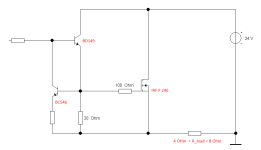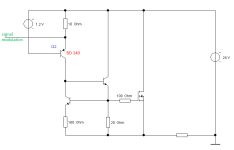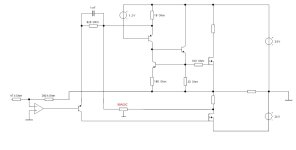Regarding PS, I modified a PNP -69 (kit from china with modern transistors) to have 'split supplies' and used a floating center point from PS caps as the 'ground'. This was fed by a SMPS. This was the best sounding version I tried of the JLH. I also had the kit shown here in the thread, but did not like the sound as much. I think the benefit of the 'floating center point' was the removal of the output and feedback caps, and PS caps acting as DC protection, but sort of in the feedback loop as I see it. The idea was from https://www.diyaudio.com/community/threads/sublimed-jlh1969.329553/
Dear HenK,
I am currently trying to sort out the content of your thread and find a common red thread for myself. After the second page of discussion, I'm already counting and looking at almost 20 circuit examples and inserted ideas ... In the meantime, the entire thread seems rather frayed to me personally.
What can we actually get involved with - a modern JLH that, like the original, impresses with its simple and very clear structure and is beautiful at first glance?
Although I can completely understand all your ideas (the ramifications), I would like to see a focus on a topology, a final definition.
At the end of the entertainment program, I wonder if there will be a rebuildable construction proposal for a Henk_JLH_2024. And also whether a beginner can learn to develop their own JLH here.
kind regards,
HBt.
I am currently trying to sort out the content of your thread and find a common red thread for myself. After the second page of discussion, I'm already counting and looking at almost 20 circuit examples and inserted ideas ... In the meantime, the entire thread seems rather frayed to me personally.
What can we actually get involved with - a modern JLH that, like the original, impresses with its simple and very clear structure and is beautiful at first glance?
Although I can completely understand all your ideas (the ramifications), I would like to see a focus on a topology, a final definition.
At the end of the entertainment program, I wonder if there will be a rebuildable construction proposal for a Henk_JLH_2024. And also whether a beginner can learn to develop their own JLH here.
kind regards,
HBt.
Do you know the power amplifier of the NAD C300? Take a close look at it, it immediately popped into my head when you introduced the MOS-Fet's.
Of course, there are also countless other well-known circuit designs.
Basically, it's an interesting topic.
Of course, there are also countless other well-known circuit designs.
Basically, it's an interesting topic.
I figured out the location of the parts for a version of the circuit with common-mode stabilization:..
I think a board measuring 100x100 will be just right for the model.
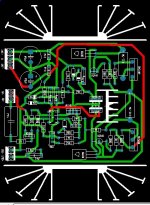
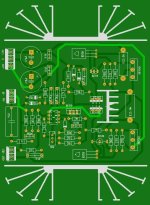
https://www.diyaudio.com/community/threads/hennadys-take-on-the-1969-jlh.409972/post-7642083
I think a board measuring 100x100 will be just right for the model.


https://www.diyaudio.com/community/threads/hennadys-take-on-the-1969-jlh.409972/post-7642083
Last edited:
If you heard how “tight and powerful” now the modified version plays bass, and “clean airy mids”, and “soft highs”. maybe you would like this version too.)))This was the best sounding version I tried of the JLH.
I looked at the service manual for this amplifier - no, it doesn’t even come close in topology to the variant with common-mode stabilization.Do you know the power amplifier of the NAD C300? Take a close look at it, it immediately popped into my head when you introduced the MOS-Fet's.
In my version, Q2 blocks nonlinear feedback through the upper of the power transistors.
Last edited:
Let's see what the phrase "commen-mode-stabilization" actually means: "Gleichtakt-Aussteuerungs-Stabilisation"
But we seem to be approaching our goal, and a first layout is now available: the Henk "Gleichtakt-Aussteuerungs-Stabilisierungs JHL-Ding" Amplifier 2024 with Hex-Fet IRFP240.
Well, that's not what I said.I looked at the service manual for this amplifier - no, it doesn’t even come close in topology to the variant with common-mode stabilization.
In my version, Q2 blocks nonlinear feedback through the upper of the power transistors.
But we seem to be approaching our goal, and a first layout is now available: the Henk "Gleichtakt-Aussteuerungs-Stabilisierungs JHL-Ding" Amplifier 2024 with Hex-Fet IRFP240.
Well, the output power transistors of the same conductivity type are controlled for symmetry by a common-mode signal. stabilizing this signal increases its symmetry.Let's see what the phrase "commen-mode-stabilization" actually means: "Gleichtakt-Aussteuerungs-Stabilisation"
Last edited:
This is for the bipolar option.But we seem to be approaching our goal, and a first layout is now available: the Henk "Gleichtakt-Aussteuerungs-Stabilisierungs JHL-Ding" Amplifier 2024 with Hex-Fet IRFP240.
For the unipolar option there is already one and it also works very well:
https://www.diyaudio.com/community/threads/hennadys-take-on-the-1969-jlh.409972/post-7636101
+ electronic filter: https://www.diyaudio.com/community/threads/hennadys-take-on-the-1969-jlh.409972/post-7635766
In my version, Q2 blocks nonlinear feedback through the upper of the power transistors.
Please explain this point in an understandable and technically correct way.
Attachments
Now you take an operational amplifier and put it in front of the input as a differential point. This is not art.
Dear Hennady,
I don't recognize anything special or even new.

Dear Hennady,
I don't recognize anything special or even new.
Last edited:
Its not about new or special. Its just Hennady's new take(s) on JLH. Please suggest improvements.Dear Hennady,
I don't recognize anything special or even new.
Cheers!
Of course, in your “art” or, more precisely, lack thereof, the scheme will not work and you will not learn anything new)))I don't recognize anything special or even new.
Dear Hennady,
the whole egg dance revolves around the so-called quiescent current stabilization (nothing else).
Your 40W at 4 Ohm load specification is very brave of you with peak currents of 4.5A sinusoidal, let's see how long a single IRF on its tiny heat sink can survive.
Now please put an iron in the fire that can really be forged, everything else is just playing around with MicroCap12 - and you know it.
This all has nothing to do with the fantastic JLH amplifier, which I think is a great pity.
Hennady is welcome to share his open brainstorming with us readers, that's absolutely no problem.
the whole egg dance revolves around the so-called quiescent current stabilization (nothing else).
Your 40W at 4 Ohm load specification is very brave of you with peak currents of 4.5A sinusoidal, let's see how long a single IRF on its tiny heat sink can survive.
Now please put an iron in the fire that can really be forged, everything else is just playing around with MicroCap12 - and you know it.
This all has nothing to do with the fantastic JLH amplifier, which I think is a great pity.
Improvements to what?Its not about new or special. Its just Hennady's new take(s) on JLH. Please suggest improvements.
Cheers!
Hennady is welcome to share his open brainstorming with us readers, that's absolutely no problem.
That’s right - that’s what common-mode stabilization is called.Dear Hennady,
the whole egg dance revolves around the so-called quiescent current stabilization (nothing else).
You simply don’t see (don’t want to see) the result of this stabilization.
A distortion in the current of the lower arm of the power transistor leads to a distortion in the symmetry of the control transistors, this is necessary so that the sinusoid becomes more similar to a sinusoid.
- Home
- Amplifiers
- Solid State
- Hennady's take on the 1969 JLH
